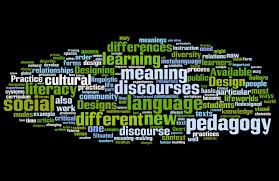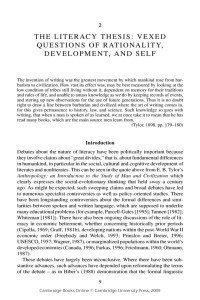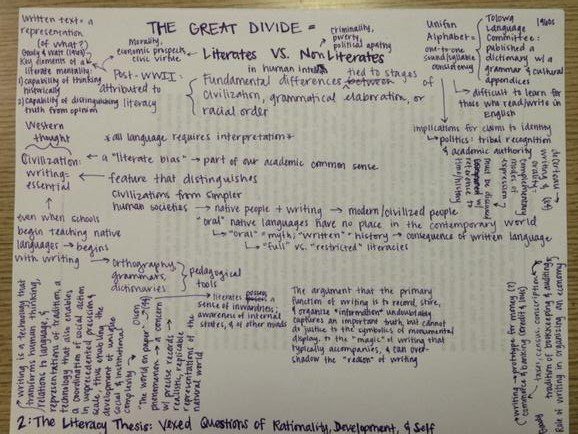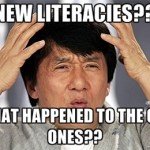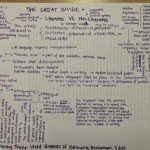
Kelsey King: Brandt and Clinton- “Limits of the Local: Expanding Perspectives on Literacy as a Social Practice”
Brandt and Clinton- “Limits of the Local: Expanding Perspectives on Literacy as a Social Practice”
In the introduction to this piece an important quote stood out as defining the goals of Brandt and Clinton. “To open new directions for literacy research we suggest more attention be paid to the material dimensions of literacy. Drawing on the work of Bruno LaTour (1993, 1996), we seek to theorize the transcontextualized and transcontextualizing potentials of literacy – particularly its ability to travel, integrate, and endure. Finally, we propose a set of analytical constructs that treat literacy not solely as an outcome or accomplishment of local practices, but also as a participant in them. By restoring a ‘thing status’ to literacy, we can attend to the role of literacy in human action. The logic of such a perspective suggests that understanding what literacy is doing with people in a setting is as important as understanding what people are doing with literacy in a setting” (337). This perfectly introduces and summarizes what they set out to do in their research on literacy. They go on to discuss how they want to push against the “great Divide” or “autonomous model” which treats literacy as decontextualized and a decontextualizing technology.
They deal with looking at the local contexts of literacy aside from just local practice. Literacy itself participates in social practices as an object or technology, but studying it in this context has been an undertheorized practice. Brandt and Clinton, in response to this, set out to dissolve the dichotomies of the local and global, agency and social structure, and literacy and its technology by treating it as a participant in local practices rather than just an outcome. In other words, literacy, as LaTour would say, is an actant (actor) not just a result.
Moving into a discussion of preceding literacy theorists, they critique Jack Goody, Walter Ong, and David Olson for the oral literate dichotomies produced from their work such as oral cultures being primitive and writing and reading cultures being civilized. Brandt and Clinton criticize this way of thinking about literacy, bringing up the fact that there are many other studies that have been performed which push against that sort of dichotomy. Scribner and Cole, for example, claim that what literacy does to you depends on what you do with it. Another critic of those scholars, Brian Street, whose work in the New Literacy Studies has been important to the field of literacy studies, felt their theories were methodologically overreaching and ideologically suspect. According to Street’s perspective, social context organizes literacy, rather than the other way around. Context is important to revisionist thinking because it illuminates the agency involved in literacy use. Agency itself ties heavily into the social practice perspective, and this is evident when local readers and writers are observed making meaning of literacy on their own terms.
The oral societies that have received so much criticism and been viewed as lacking civility, among other things, upon reexamination, reveal that without technology of literacy oral people exhibit logical reasoning, historical consciousness, skepticism, differentiation, and complex organization- all of which had been reserved for describing literate societies from the “Great Divide” theory. Now, orality has emerged as a powerful technology, and talking is the primary form of teaching reading and writing, as well as in negotiating understanding of written language. With that in mind, it is easy to realize that Goody, Ong, and Olson had too much stock in reading and writing, and not enough in the importance of orality as coming alongside the two. Instead, they were feeding the dichotomies which have so often positioned the West against the East or Other. This reversal shows that we need to move from text to context and unify orality and literacy, which can also be described as the literacy event and literacy practice.
What is the difference between a literacy event and a literacy practice? According to Brandt and Clinton, literacy events are seen as discrete and observable happenings and practices are abstract, enduring, and not completely observable. Out of this concept came ethnographic studies which paid attention to what individuals read and write, when, where, how, and why. In other words, their focus shifted to the flow of literacy in and around daily activity and its relationship to other social practices. Much of these studies countered the claims about literacy that came out of the autonomous model. At the same time though, Brandt and Clinton are concerned with if it is possible to recognize and theorize the transcontextual aspects of literacy without calling it decontextualized. They ask, “Can we not approach literacy as a technology – and as an agent – without falling back into the autonomous model?” To wrestle with these questions they move on to discuss expanding perspectives on social practice. However, I am not quite sure that this question is fully answered.
Through studying local contexts to understand local literacy we can also look to the local literacy practices to understand what organizes local life. An example of this is seen in Besnier’s ethnography, “Literacy, Emotion, and Authority: Reading and Writing on a Polynesian Atoll”, on the Nukulaelae people who wear American t-shirts with slogans they don’t understand, some of which are offensive or risque. The print on the shirts fell outside local relevance, and they had no interest in what the shirts say because they didn’t play a part in any recognizable literacy events. At the same time, these t-shirts entered into the cultural and historical facts of the island without a local literacy event mediating permission. The slogans themselves demonstrate the reach of a global market economy into family gift-giving and personal possessions. The Nukulaelae ignore the print, but the print also ignores them while incorporating them into Western commercialism, thus demonstrating that the technologies of literacy have the capacity to travel, stay intact, be visible and animate outside the interactions of immediate literacy events.
This is where LaTour truly enters the picture, and we end up seeing that a huge problem with literacy events, as defined by the social practice perspective, is that it comes across as overwhelmingly particular and situated under the ethnographic gaze. The issue we often fail to consider is that the objects in literacy events are contextually active participants, and we generally think of them only in terms of their function locally and interactively. The social practice perspective asserts that human agents, whether individually or collectively, mediate literacy practices whenever they take them up and use them to fulfill the needs at hand. Additionally, objects as active mediators imbue, resist, and recraft. At the same time, LaTour emphasizes that everything is local and made of local interactions, but local events can have globalizing tendencies and globalizing effects, accomplished through the mediation of globalizing technologies (347). The point he is getting at is that we need to take on a perspective that acknowledges how extensively literacy plays into building networks across time and space with de-localizing and re-framing social life, and with its centralizing power in which the social world is organized and connected, all of which can be accomplished by investigating local life.
As was mentioned in the introduction to this piece, Brandt and Clinton suggest that understanding what literacy is doing with people in a setting is as important as understanding what people are doing with literacy in a setting. They add to this by discussing how LaTour states that things are actors themselves– they can serve as “comrades, colleagues, partners, accomplices or associates in the weaving of social life” (348).By taking on this view, it becomes possible to explore many other important questions. By replacing the literacy event, which privileges human actors of non-human actors, with the “literacy-in-action” concept we can look analytically at the objective trace of literacy in a setting whether or not they are taken up by local actors. An example of this would be the Nukulaelae with the t-shirts in which residents do not act to incorporate the slogans messages into their immediate interpretation, while at the same time the print communicates the incorporation into the global market system of the Nukulaelae.
Brandt and Clinton then go on to discuss sponsors of literacy, the ideas which we read about in week 3 of our course. In this section, they discuss how identifying sponsors at scenes of reading and writing links humans and things in two important ways: It allows us to always ask about the literacy materials in a setting and it helps to clarify the multiple interests or agents that are usually active when writing and reading are taken up. Attention to sponsors provides insight into how literate practices can be shaped out of the struggle of competing agents and interests, and also how multiple interests can be satisfied by one literacy event. More importantly, in my opinion, it allows us to see the correlation between the literacy practice and social relationships while answering distant demands demonstrating the agency is oftentimes multisourced.
In the subsequent section they introduce a series of LaTour’s terms that bring new perspective to literacy as a social practice. The first term: Localizing moves encompasses actions of humans and things in framing or partitioning particular interactions. Since literacy objects in action often localize a context by framing it or holding it in place, they can also perform other localizing moves like the sharing of cultural habits or by mediating a local social structure. The second term: Globalizing Connects, which can be accomplished by human and nonhuman actors, is identified as the shift out of individuals and the knitting together of interactions. We look to the technologies of literacy to accomplish globalizing connects as they carry reading and writing actions in and out of local contexts or consolidate them in one place (352). The third term: Folding expresses ontological relationships between people and things. In other words, a person can fold an act of doing into an object. The example used for this was the ability of the journal to travel and endure in one pieced and its ability to interact across space and time. The authors fold themselves into the Journal of Literacy Research which disseminates their article to readers while they are doing other things. By folding into the non-human, the sponsors of literacy indirectly interact with other humans.
To conclude their theoretical work, the point Brandt and Clinton are getting at from establishing these aspects of the social practice perspective is that, they can help us to consider how and how much local literacies involve importing and exporting literacy across contexts and the role of managing these movements. This leads us into questions about which contexts import and export and from where, which maintain a balance of trade, what sponsorship patterns exist across contexts, comparing differences in sponsoring power and costs, and changes in patterns of sponsorship. We can begin mapping these relationships and networks to better examine which processes sustain diversity and iniquity in literacy. Additionally, we can examine how more localized literacy networks may have less agency or power than those whose networks are more expansive. From understanding and applying these concepts, we can begin to address how forms of literacy disrupt, tear up, and destabilize patterns of social life. They believe it is necessary to focus on the material dimensions of literacy, it’s durability, capacity to connect, mediate, represent, and hold together multiple interests to accomplish these complex ways of analyzing literacies function in the world and approach the ideological struggles that accompany it.
One interesting way to look at the material dimensions of literacy and its capacity to connect, mediate, represent, and hold together multiple interests is that of the hashtag example we discussed in class. Twitter, in particular, took up the hashtag, and it now acts as a representation of different things like the black lives matter movement. It mediates multiple interests in that movement, represents multiply-configured meanings, and holds together the interests of various intersections of human identities and interests. Through the literacy object of the hashtag one can analyze these various literacy functions and visibly see the connections between what localized literacies move through time and space, and across the contexts in which it is globally situated. The hashtag is acted upon and is an actant, mediating literacies for humans, acting with globalizing tendencies, and connecting and sharing localized practices.
